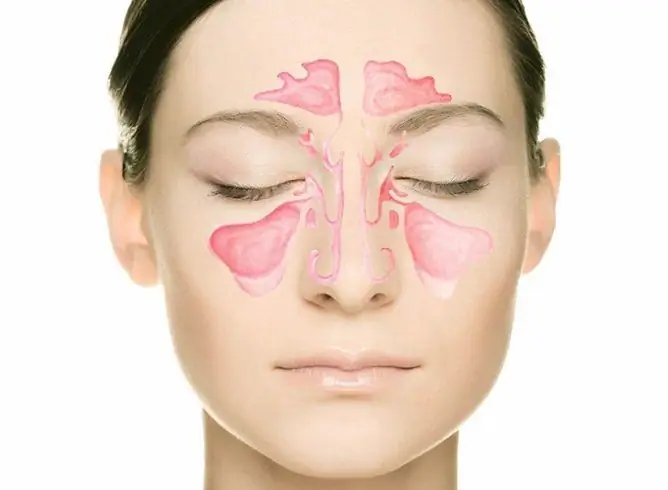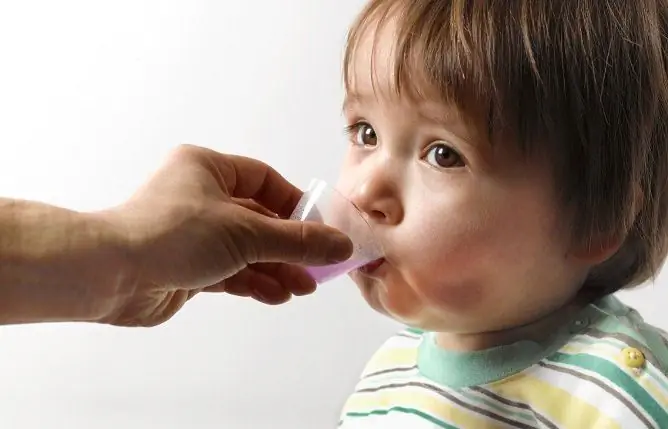- Author Rachel Wainwright [email protected].
- Public 2023-12-15 07:39.
- Last modified 2025-11-02 20:14.
Shin contusion: first aid, treatment, complications
The content of the article:
- The anatomical structure of the lower leg
- First aid
- Symptoms and Diagnosis
-
Treatment of a bruised lower leg at home
- Drug therapy
- How to treat a bruise with folk remedies
-
Possible complications
Periostitis
- Forecast
- Video
Shin contusion is a closed tissue injury without significant damage to their structure. Most often occurs due to sports injuries, falls or blunt force blows.

Shin contusions often result from sports injuries
In most cases, tissues that are located superficially are affected: skin, subcutaneous tissue, blood vessels, periosteum and muscles. With a strong impact, the soft tissues pressed against the bone are especially damaged.
If you bruise the lower leg in the area of its anterior-internal surface (in the place where the subcutaneous tissue and skin adjoin the bone), skin necrosis may occur, which leads to its subsequent rejection.
Often, at the site of application of the traumatic force, especially when the skin is detached, shallow wounds and abrasions occur, which are the entrance gate of infectious agents. In such cases, the injury is complicated by inflammation, which requires additional treatment.
The anatomical structure of the lower leg
The lower leg is the part of the lower limb from the knee to the heel. It consists of the tibia and fibula, to which the patella is attached. Above, the tibia and fibula are articulated, from below they end with two processes (external and internal ankle), along the entire length they are connected by a membrane.

The severity of trauma symptoms depends on the place of its localization on the lower leg
The soleus muscle is adjacent to the greater and fibula. The gastrocnemius muscle has two heads, one of which attaches to the lateral and the other to the medial side of the femur. In contact, both heads overlap the soleus muscle and pass into the Achilles tendon, which is attached to the calcaneus.
Muscles are attached to the back and front of the lower leg bones, which are divided into three groups:
| Group | Description |
| Front | Extend the foot and toes |
| Outdoor | Flex the foot, as well as retract and rotate it outward |
| Rear (calf) | Flex the foot and toes |
First aid
When providing first aid to the victim, if there is even the slightest suspicion of a more serious injury (in the form of a fracture, dislocation, concomitant injury, for example, with an injury to internal organs or a bruised elbow or hand), you should consult a doctor as soon as possible. The amount of assistance required should be appropriate to the severity and extent of the alleged injury.
If the integrity of the skin is violated, a sterile bandage is applied. In case of joint bruises, multiple bruises, skin detachment, transport immobilization is carried out to the nearest medical institution.
With minor bruises, the local application of cold contributes to the reduction of pain syndrome: immediately after the injury, a stream of cold water can be directed to the damaged area, a heating pad or ice pack or cold lotion can be applied to it.
Symptoms and Diagnosis
The following symptoms are characteristic of a bruised lower leg:
- hematoma and edema at the site of injury: severe contusion of the lower leg with edema is most typical for sports injuries, often pronounced signs are visible after a while;
- pain syndrome of the site of injury.
It is especially important to get tested for older women who often have osteoporosis. With this disease, fractures can occur even in the case of minor injuries.
Treatment of a bruised lower leg at home
A pressure bandage must be applied to the site of the injury. The leg needs to be calm and elevated. For several days, a gentle load mode should be observed. It expands gradually as the swelling and pain decrease.

The injured leg should be kept calm and elevated.
A few days after the injury, you can start active movements with increasing amplitude in the joints that are located near the injury site. For resorption of hematoma (bruising), you can do warming compresses, thermal procedures (warm baths, a heating pad with warm water, etc.).
With extensive bruises, therapy should be carried out strictly according to the doctor's prescription and under his supervision.
Drug therapy
In order to quickly cure a bruise, local preparations are used. They have different mechanisms of action: they reduce the area of hematoma and pain and speed up recovery. They are often used in combination with other local and systemic pain relievers.

For treatment, external agents are most often prescribed, in particular Dolobene
The main contraindication to their use is individual intolerance to the components, the most common side effect is allergic reactions.
Drugs used for hematomas and bruises:
- Traumeel S: complex homeopathic ointment. It has anti-inflammatory, decongestant, analgesic, absorbable, immunostimulating and wound-healing effects. In addition to bruises, the remedy helps to cure postoperative soft tissue edema, dislocations, sprains, is used in the complex therapy of diseases such as osteochondrosis, osteoarthritis, tendovaginitis;
- Dolobene: combined external preparation (in the form of a gel). Dimethyl sulfoxide has anti-inflammatory, decongestant and local analgesic effects; heparin helps to restore connective tissue, has an anti-inflammatory effect; dexpanthenol speeds up healing;
- Badiaga: herbal preparation in the form of a powder for preparing a suspension. It belongs to the number of local irritants, the mechanism of action is based on mechanical irritation of the skin, due to which the blood flow to the cells increases, their nutrition and respiration are restored.
When a bruise hurts so badly that it is difficult to stop with over-the-counter drugs, medications are shown that require a prescription from a doctor.
How to treat a bruise with folk remedies
In uncomplicated cases, traditional medicine can be used. External remedies can be used only in the absence of severe symptoms and violations of the integrity of the skin.

At home, potato starch can be used to reduce bruising symptoms.
Recipes to help hematoma resorption:
- potato starch. Water is added to the starch until a gruel is obtained, which should be applied to the site of the injury for half an hour. The hematoma usually begins to change its color after 2-3 days of therapy. For the same purpose, you can use fresh potatoes, chopped with a grater;
- onions with salt. For a compress, grate the onion on a fine grater and mix the gruel with one tablespoon of salt. The mixture should be wrapped in gauze and applied to the bruise twice a day. Treatment is carried out until the hematoma disappears;
- acetic salt solution. To prepare a solution in 200 ml of 9% vinegar, dissolve one teaspoon of salt. A cotton swab dipped in the resulting mixture is applied to the impact site twice a day for 30 minutes. The procedure can be repeated until the hematoma disappears completely;
- iodine. The iodine grid helps to enhance local blood circulation and reduce blood stagnation.
Possible complications
The easiest and most common complication of a bruise is a lump (lump). It usually appears after a hematoma in places where fatty tissue is almost completely absent under the skin.
How pronounced this violation and how long it goes away depends on many factors, including the severity and nature of the blow. If the lump persists for more than a week, you should consult your doctor, as this may indicate calcification of the hematoma.
Periostitis
A bruise of the periosteum can lead to a more serious complication - periostitis. This is an inflammation of the periosteum, which usually begins in the outer or inner layer and then spreads to the rest of the layers. The inflammatory process can easily pass from one tissue to another, since there is a close relationship between the bone and the periosteum.

Periostitis is a common complication of a leg injury.
According to the clinical course, pathology is divided into acute (subacute) and chronic forms. Most often, the periosteum is affected in the area of bones, which is poorly protected by soft tissues, in particular, on the anterior surface of the tibia.
A simple periostitis is characterized by an acute aseptic inflammatory process with hyperemia, slight thickening and infiltration of the periosteum. It is accompanied by swelling and pain in a limited area. The inflammation usually subsides quickly, but sometimes fibrous growths or deposits of calcium salts are possible.
Forecast
In most cases, the prognosis is favorable. As a rule, complete recovery from minor injury occurs within 2-3 weeks. In more severe cases, the recovery period is longer, sometimes several months.
It is important to remember that if the symptoms of a bruised lower leg, despite the treatment, do not subside or worsen, you should consult a doctor, which will help to avoid the development of serious consequences.
Video
We offer for viewing a video on the topic of the article.

Anna Kozlova Medical journalist About the author
Education: Rostov State Medical University, specialty "General Medicine".
Found a mistake in the text? Select it and press Ctrl + Enter.






